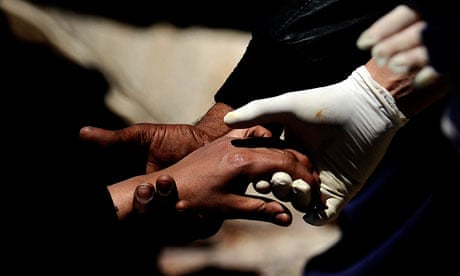The Spanish government has challenged a claim by Nato that the alliance forwarded a distress call to a nearby Spanish warship that might have saved the lives of 63 African migrants adrift in the Mediterranean. It said that if there was such a message, Nato should be able to « prove it ».

Pressure is mounting on Nato to respond to a series of unanswered questions concerning the tragedy of the migrant boat, with European politicians repeating their demands for a further inquiry and human rights lawyers announcing the launch of legal action against those responsible for the « avoidable » loss of life.
On Wednesday the Guardian revealed the findings of a damning official report into the fateful voyage, which saw 72 sub-Saharan refugees drifting in the sea for two weeks and all but nine of them dying of thirst and starvation. This was despite them being located by European authorities and distress calls being broadcast from Rome to all other ships in the area.
The report by the Council of Europe blamed a collective set of « human, institutional and legal » failures for the inaction and labelled it a « dark day for Europe ».
It concluded that the large loss of life could have been avoided if the various agencies in the area – Nato, its warships, the Italian coastguard and individual European states – had fulfilled their basic obligations.
Despite initially insisting that Nato « had not logged any distress signals from the boat and had no records of the incident », this week the organisation admitted it had received a fax giving details of the troubled boat and its precise location.
A spokesman claimed the information « was forwarded to Nato taskforce units under its operational control », which would have included the Méndez Núñez, a Spanish frigate equipped with helicopters that was positioned only a few miles from the migrants at the time.
On Thursday the Spanish ministry of defence denied that any such communication was received. « The frigate did not receive any notification from the Maritime Rescue Co-ordination Centre of Rome or from the Nato command in Naples, » spokesman Miguel Morer told the Guardian.
He said that if they had been aware of the migrant boat’s plight, Spanish forces would have moved quickly to effect a rescue. « If [any notification] was sent then there must be a record … so if Nato says there was a message, then it should be able to prove it. » Nato said it did not have any further information on the matter.
The gravity of the dispute was underlined when International Federation of Human Rights lawyers said they would launch criminal lawsuits against those they believe responsible for ignoring the migrants’ plight.
« There is no doubt that someone, somewhere, has criminal responsibility for the deaths of these people, » said Stéphane Maugendre, president of the Paris-based Groupe d’Information et de Soutien des Immigrés [Group for information and support of immigrants]. He said legal action would initially be launched in France as the French military had « the largest presence » in the Mediterranean at the time, but said co-ordination was already under way for similar lawsuits in other European countries.
In a press conference in Brussels, the Council of Europe rapporteur charged with investigating the deaths repeated her demand that Nato release classified satellite imagery of the area in an effort to establish the identities of a large military vessel and an army helicopter, which survivors claim both made direct contact with their boat but then refused to offer assistance. She also criticised the agency for its ‘inconsistent’ responses to her investigation and said there had not been sufficient planning by Nato or the UN regarding the inevitable exodus of migrants from North Africa during the military campaign in Libya.
« This was a military zone under Nato’s control and under close surveillance by them, but still there was no reaction to the distress calls, » argued Tineke Strik, the politician behind the council’s report. « There should be an inquiry into Nato’s actions and it’s something they could do themselves through their own assembly. They have all the information, all the satellite [data], they have the logs of helicopter movements and so there must be communication that makes it very clear where this helicopter came from, for example, and why a decision was taken not to intervene. »
Judith Sunderland, a senior researcher at Human Rights Watch, echoed calls for further investigation. « The main message in the Council of Europe report is that many different actors – Nato, individual warships under Nato command, the Italian authorities, as well as fishing vessels – could have saved these 63 human beings, but didn’t, » she said.
« Many questions remain unanswered, and it’s high time that Nato and its member states conduct serious inquiries into what led to these tragic deaths, and examine what more can be done to prevent further deaths at sea. »
Confusion continues to surround the fate of another set of emergency messages broadcast by the Italian coastguard appealing for nearby vessels to help save the migrants. Sent over the Inmarsat and Hydrolant communication systems, which all vessels, including military ships, are supposed to be equipped to receive, the messages were labelled « Priority: Distress », the highest emergency phrase possible under the international search and rescue convention. But the Spanish authorities claim no such calls were received. « We deny absolutely having received these messages on the frigate, » a spokesman said.